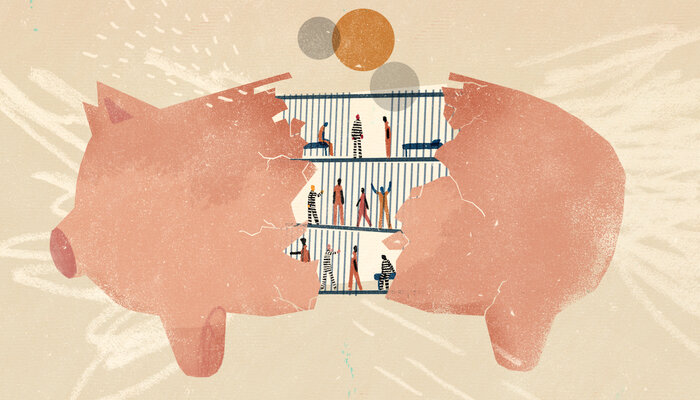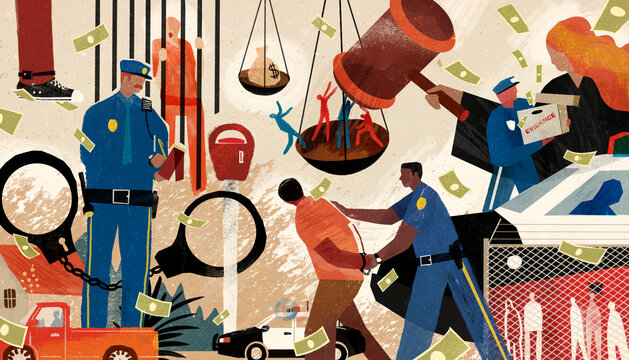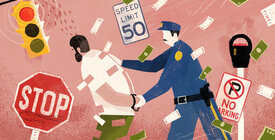
Revenue Over Public Safety
Resumen: Financial incentives throughout the criminal justice system encourage punitive enforcement and sustain mass incarceration. Realigning them will require action from municipalities to the federal government.

Part of
Bipartisan efforts to change the criminal justice system have gained momentum around the country in recent years. Nearly all 50 states, many counties, and the federal government have sought to reduce imprisonment and mitigate its harms. 1 A remarkable wave of legislation has shortened custodial sentences and widened eligibility for sentences served in the community. States and localities have also invested in rehabilitation and reentry services.
Yet the impact of these efforts has been relatively modest. While the nation’s imprisoned population has declined since peaking in 2009, incarceration levels remain extraordinarily high (see figure 1). 2 Nearly 1.2 million people are serving sentences in state and federal prisons, and 10.3 million are admitted to local jails every year.3 Mass incarceration — a term now entrenched in the popular lexicon — is proving remarkably resistant to well-intentioned reforms.4
One explanation can be found in the infrastructure erected to support the United States’ reliance on imprisonment as the country’s primary crime control policy. Mass incarceration did not result simply from increased policing and harsher criminal penalties. 5 Economic and financial incentives established by local, state, and federal agencies also played a role. Police, prosecutors, and corrections agencies competed for these benefits by escalating their enforcement practices. Law enforcement came to depend on these funding sources, particularly as declining tax receipts and intergovernmental transfers left them grasping to fill budget holes. 6 These incentives are a persistent structural driver of punitive enforcement and mass incarceration.
The perverse financial incentives of direct federal funding programs for incarceration are relatively easy to identify. So too are laws passed by Congress that encourage more punitive policies. 7 This report focuses instead on an interlocking set of economic incentives that are more deeply entrenched and difficult to unravel. These incentive structures raise the risk that officials will chase revenue rather than pursue public safety and justice, giving law enforcement agencies a stake in perpetuating mass incarceration. This report catalogs some of the most corrosive practices.
These perverse economic incentives fall into three primary categories:
- User-funded justice. Through mechanisms such as civil asset forfeiture, fines and fees, and privatized community supervision, the very people subjected to criminal enforcement activities are routinely made to contribute to the cost of their being arrested, detained, charged, prosecuted, supervised, or incarcerated. Law enforcement officials and agencies reap the benefits while those trapped in the system struggle to pay.
- Correctional and detention bed markets. Officials seeking to alleviate prison and jail overcrowding by renting space from other jurisdictions have created a market in incarcerated people. The federal government has exacerbated this demand for bed space, particularly through stepped-up immigration enforcement. Fiscally distressed counties have seen this market as a solution to their budget woes, often expanding their jails to serve it. Incarcerated people, meanwhile, are reduced to dollars and cents in this rent-seeking ecosystem of carceral institutions seeking to maintain or grow their operations.
- Enforcement-oriented performance metrics. Police departments and prosecutors’ offices reward staff for meeting productivity-based job metrics, such as arrest quotas and high conviction rates, and penalize those who fall short. With their job security and career advancement at stake, law enforcement officials are incentivized to pursue punitive measures even when leniency might be more appropriate.
In recent years, policymakers have come to see how these practices exacerbate poverty, create conflicts of interest for officials, and disproportionately harm communities of color. This has helped drive progress. But reforms that target specific incentives in isolation can have unintended consequences. A rollback of fines and fees, for example, may simply drive officials to increase civil asset forfeitures to fill the anticipated revenue gap. Proposals to reduce jail and prison populations by moving people into privatized community supervision may enrich for-profit firms while saddling people with costs they cannot afford.8
The array of perverse incentives in the criminal legal system makes unwinding mass incarceration extraordinarily difficult. A comprehensive approach will require an all-out mobilization by Congress, state legislatures, local governments, and law enforcement agencies. To decrease the number of people under correctional control, policymakers must unravel these deeply embedded economic incentives. At the same time, dissuading public safety agencies from preying on the very people they are charged with protecting will require that they be adequately and equitably funded. This report maps out the perverse incentive structures that have helped perpetuate the United States’ overly harsh system of punishment and outlines reforms that can eliminate, change, or realign them, moving the country toward a more fair and just criminal justice system.
Notas al Pie
-
1
Rebecca Silber, Ram Subramanian, and Maia Spotts, Justice in Review: New Trends in State Sentencing and Corrections 2014–2015, Vera Institute of Justice, 2016, 4–5, https://www.vera.org/downloads/publications/state-sentencing-and-corrections-trends-2014–2015-updated.pdf [https://perma.cc/RTB4-MSS8]. For county-level reforms, see, for example, Shannon Heffernan, “Report: Cook County Bail Reform Reduced Jail Population Without More Crime,” NPR, May 13, 2019, https://www.npr.org/local/309/2019/05/13/722286868/report-cook-county-bail-reform-reduced-jail-population-without-more-crime [https://perma.cc/M66F-Q3FY]; Alvaro Ortiz, “Federal Judge Approves Settlement Over Historic Lawsuit on Harris County Bail System,” Houston Public Media, September 5, 2019, https://www.houstonpublicmedia.org/articles/news/local/2019/09/05/345121/federal-judge-approvessettlement-over-historic-lawsuit-on-harris-county-bail-system/ [https://perma.cc/G4T3–6U36]; and Harris County Criminal Lawyers Association, Amended Local Rule 9.1 (Misd Bail Policies), January 23, 2019, https://hccla.org/member-files/amended-local-rule-9–1-misd-bail-policies-1–16–19/ [https://perma.cc/YR8M-TWSE]. In the past decade, Congress enacted two major federal criminal justice reform bills: the Fair Sentencing Act and the First Step Act. See Fair Sentencing Act of 2010, Pub.L. 111–220, 124 Stat. 2372, https://www.govinfo.gov/content/pkg/PLAW-111publ220/pdf/PLAW-111publ220.pdf [https://perma.cc/Z7ZX-EXHL]; and First Step Act of 2018, Pub.L. 115–391, 132 Stat. 5194, https://www.govinfo.gov/content/pkg/PLAW-115publ391/pdf/PLAW-115publ391.pdf [https://perma.cc/R4CA-F2EU]. -
2
Silber, Subramanian, Maia Spotts, Justice in Review: New Trends. See also First Step Act of 2018. -
3
For prison populations, see Jacob Kang-Brown, Chase Montagnet, and Jasmine Heiss, People in Jail and Prison in Spring 2021, Vera Institute of Justice, 2021, 1, https://www.vera.org/downloads/publications/people-in-jail-and-prison-in-spring-2021.pdf [https://perma.cc/G3XK-KCG4]. For jail admissions, see Zhen Zeng and Todd Minton, Jail Inmates in 2019, U.S. Department of Justice, Office of Justice Programs, Bureau of Justice Statistics, 2021, 1, https://bjs.ojp.gov/content/pub/pdf/ji19.pdf [https://perma.cc/E8QM-7BBU]. -
4
David Garland described the distinctive expansion of “mass imprisonment” in the United States between 1975 and the late 1990s as deriving from a new regime of criminal penalties that raised incarceration rates on a quantum scale, applying policies and practices to entire categories of people rather than individuals. See David Garland, ed., Mass Imprisonment: Social Causes and Consequences (London: Sage, 2001). The terms “mass imprisonment” and “mass incarceration” were adopted by many other criminologists as well as civil rights activists. See, for example, Bruce Western, Punishment and Inequality in America (New York: Russell Sage Foundation, 2006); Marc Mauer and Meda Chesney-Lind, eds., Invisible Punishment: The Collateral Consequences of Mass Imprisonment (New York: The New Press, 2002); and Michelle Alexander, The New Jim Crow: Mass Incarceration in the Age of Colorblindness (New York: The New Press, 2012). The terms were eventually even absorbed into the language of officials. For example see, President Barack Obama, “Remarks by the President at the NAACP Conference,” speech delivered at the 2015 NAACP conference, Philadelphia, Pennsylvania, July 14, 2015, https://obamawhitehouse.archives.gov/the-press-office/2015/07/14/remarks-president-naacp-conference [https://perma.cc/XM8C-XLVJ]. -
5
For a discussion of the increasingly punitive policy landscape that has contributed to higher rates of incarceration, see Jeremy Travis, Bruce Western, and Steve Redburn, eds., The Growth of Incarceration in the United States: Exploring Causes and Consequences (Washington, DC: The National Academies Press, 2014), 70–89. -
6
Heather Schoenfeld, Building the Prison State: Race and the Politics of Mass Incarceration (Chicago: University of Chicago Press, 2018), 211–16 (arguing that the constituencies that helped grow and sustain mass incarceration are not likely to relinquish their stake in it because they believe the business of mass incarceration “sustains livelihoods, grows careers and supports communities”). -
7
For example, the Violent Crime Control and Law Enforcement Act of 1994 incentivized states to pass “truth in sentencing” laws that reduced the availability of parole by promising millions of dollars to compliant jurisdictions to use to expand their capacity for incarceration. Violent Crime Control and Law Enforcement Act of 1994, Pub.L. 103–322, 108 Stat. 1796, https://www.govinfo.gov/content/pkg/STATUTE-108/pdf/STATUTE-108-Pg1796.pdf [https://perma.cc/HF3Z-E6GL]. Approximately $2.7 billion was awarded between FY 1996 and 2001 as grants to the states and territories for constructing, expanding, or renovating correctional facilities. See U.S. Department of Justice, Bureau of Justice Assistance, Report to Congress: Violent Offender Incarceration and Truth-in-Sentencing Incentive Formula Grant Program 1, 2012, 6, https://bja.ojp.gov/sites/g/files/xyckuh186/files/media/document/voitis-final-report.pdf [https://perma.cc/QTG7-EZPV]. -
8
Michelle Alexander, “The Newest Jim Crow,” New York Times, November 8, 2018, https://www.nytimes.com/2018/11/08/opinion/sunday/criminal-justice-reforms-race-technology.html [https://perma.cc/BSW8–6FC3].
Más sobre la How Perverse Financial Incentives Warp the Criminal Justice System series
-
Hay que prohibir las cuotas policiales
Las cuotas policiales no mejoran la seguridad de las comunidades, sino que impiden que los oficiales de policía concentren sus esfuerzos en resolver otros problemas más grandes de seguridad pública. -
How Electronic Monitoring Incentivizes Prolonged Punishment
An innovative method to help reduce mass incarceration is often derailed by outrageous fees and onerous rules that can send people back to prison. -
In the Criminal Justice System, Don't Sacrifice Public Safety for Profit
Financial motivations — and their budgetary effects — have become persistent and self-reinforcing. Nevertheless, we can rebalance the scales of justice, and we must.








